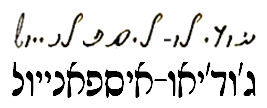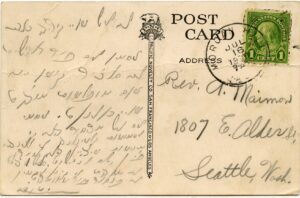Solitreo
What is Solitreo?

Solitreo is a cursive form of the Hebrew alphabet that was traditionally used by Sephardic Jews in the Ottoman empire for writing Ladino. It is the predecessor of modern day Hebrew cursive as well as the predecessor to Rashi script. Rashi script (and its sister Yiddish script, Vaybertaytsh), is based off of the Sephardic Solitreo cursive script which was used centuries after Rashi’s death in printed books to differentiate it from the text of the Torah. The word Solitreo, is derived from Galician-Portuguese, meaning ‘to spell.’ Starting in the 15th century, a printing font for Rashi script was used for formal Ladino manuscript writing and for the main portion of most printed texts. Block Hebrew letters were usually reserved for headings.

Before WWII, Solitreo cursive was primary used for handwritten correspondence between Ladino speakers. Starting in the 19th century, published Ladino texts began to use Roman letters rather than Hebrew letters. Solitreo was still designated for only for handwriting. Sephardic Jews, like other Jewish communities, considered Hebrew to be the holy language of learning, and Ladino was reserved for literature, personal and business correspondence. Therefore, a great amount of the Torah commentaries by Sephardic Jews was written in Hebrew rather than Ladino. There were a few exceptions to this, an example being the ‘Meam Loez’, by Rabbi Yaacov Culi, which was written in Ladino and published 1746.
Solitreo are the letters that Sepharadim used for hundreds of years to communicate and compose to one another after their expulsion from the Iberian Peninsula. The number of people left in the world that can still read Solitreo is around 100, but the font itself can easily be picked up and, with a little effort, learnt by someone familiar with Rashi script.
How Solitreo can help decode the past
“What is the point of learning an alphabet that almost nobody uses?”
Solitreo has become the language of reading, writing, and understanding of another world and another time — one that connects us to the generations of Sephardic exiles.

Solitreo helped Sephardic communities that were dispersed from one another stay connected. For scholars in Sephardic, Ottoman, and Jewish history, learning Solitreo is crucial to understanding how Sephardic Jews communicated with each other. All the ancestral stories, folklore and letters from these communities are recorded in Solitreo script. Once Solitreo and Ladino become lost, we risk losing all of the precious layers of history that are wrapped up with them.
The number of people in the world that can read Solitreo is around 100 people
